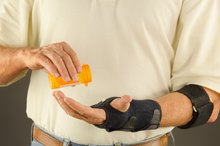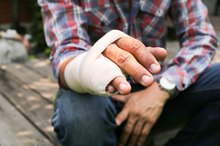What does fact checked mean?
At Healthfully, we strive to deliver objective content that is accurate and up-to-date. Our team periodically reviews articles in order to ensure content quality. The sources cited below consist of evidence from peer-reviewed journals, prominent medical organizations, academic associations, and government data.
- "Molecular Cell Biology:" Collagen: The Fibrous Proteins of the Matrix
- "Molecular Cell Biology:" Collagen: The Fibrous Proteins of the Matrix
- MyFoodData: The Top 10 Foods Highest in Vitamin C
- MyFoodData: The 10 Best Foods Highest in Magnesium
The information contained on this site is for informational purposes only, and should not be used as a substitute for the advice of a professional health care provider. Please check with the appropriate physician regarding health questions and concerns. Although we strive to deliver accurate and up-to-date information, no guarantee to that effect is made.
How to Regrow Collagen in the Knee
Collagen is a plentiful protein and vital component of muscles, organs, skin, tendons and connective tissue, such as cartilage. Cartilage, found in the knee and throughout the body, acts as shock-absorbing padding between bones, protecting joints and facilitating movement. With age, collagen production slows and cartilage degenerates, often resulting in pain, stiffness and inflammation that can lead to osteoarthritis. Food alone can't replace collagen in your knee joints, but certain nutrients can help preserve the collagen you have and optimize your body’s own collagen synthesis.
Collagen and Protein Connection
Collagen is the main protein in cartilage, ligaments and bone. Your body makes collagen by combining amino acids 1. Although your body can produce some amino acids on its own, others need to be derived from food. Focus on eating foods that are complete proteins, meaning that they contain all nine essential amino acids that the body can't make. These foods include:
- red meat
- poultry
- fish
- quinoa
- soybeans
- eggs
- cheese
- milk
- yogurt
- Collagen is the main protein in cartilage, ligaments and bone.
- Although your body can produce some amino acids on its own, others need to be derived from food.
Vitamin C for Preservation
Supplements for Shoulder Injuries
Learn More
Because vitamin C is water soluble, you need to consume foods rich in vitamin C every day just to reach the recommended daily value of 75 to 90 milligrams 4. Foods that contain the most vitamin C include:
- kiwi
- guavas
- bell peppers
- Brussels sprouts
- strawberries
- oranges
- tomatoes
- green chilies
- papayas
- broccoli
- kale
- snow peas 4
Magnesium for Healing
All components of connective tissue, including collagen, depend on magnesium. Approximately half of the magnesium in your body is concentrated in your bones, according to the San Diego Center for Health 6. Magnesium helps modulate the synthesis and healing of collagen connective tissue and is necessary for the conversion of vitamin D for absorption of calcium in bone matrix. Magnesium regulates the protein compound proteoglycan, which strengthens connective tissue, and glycoprotein, involved in the healing of connective tissue.
Try to get at least the recommended daily value for magnesium — 320 milligrams for women and 420 milligrams for men.
Read More: The Benefits of the Magnesium Mineral
- All components of connective tissue, including collagen, depend on magnesium.
- Magnesium helps modulate the synthesis and healing of collagen connective tissue and is necessary for the conversion of vitamin D for absorption of calcium in bone matrix.
Collagen Supplements
Collagen Functions
Learn More
Although it's always best to get your nutrients naturally from a well-balanced diet, collagen supplements are always an option — available in several different forms, including gelatin, hydrolyzed and undenatured. Some supplements, such as collagen peptides, are promoted as beneficial for arthritis by helping your bones and joints 8. Gelatin and hydrolyzed collagen supplements break down the amino acids to make them more easily digested and absorbed 8. In powdered form, collagen supplements can be added to smoothies or other beverages, or added to baked goods.
Read More: Exercises for Damaged Knee Cartilage
Related Articles
References
- Cleveland Clinic: The Best Way You Can Get More Collagen
- Center for Nutrition Studies: Drinking Bone Broth: Is it Beneficial or Just a Fad?
- MyFoodData: The Top 10 Foods Highest in Vitamin C
- Dietary Guidelines 2015-2020: Nutritional Goals for Age-Sex Groups Based on Dietary Reference Intakes and Dietary Guidelines Recommendations
- MyFoodData: The 10 Best Foods Highest in Magnesium
- Arthritis Foundation: Are Collagen Supplements Helpful for Arthritis?
- Enigmatic insight into collagen - PubMed
- The collagen family - PubMed
- Hydrolyzed Collagen-Sources and Applications - PubMed
- Hydrolyzed Collagen-Sources and Applications - PubMed
- Vitamin C in dermatology - PubMed
- Beneficial effects of food supplements based on hydrolyzed collagen for skin care (Review) - PubMed
- Collagen supplementation for skin health: A mechanistic systematic review - PubMed
- A Collagen Supplement Improves Skin Hydration, Elasticity, Roughness, and Density: Results of a Randomized, Placebo-Controlled, Blind Study - PubMed
- Oral Collagen Supplementation: A Systematic Review of Dermatological Applications - PubMed
- Fish Collagen Surgical Compress Repairing Characteristics on Wound Healing Process In Vivo - PubMed
- The wound healing potential of collagen peptides derived from the jellyfish Rhopilema esculentum - PubMed
- Natural composite dressings based on collagen, gelatin and plant bioactive compounds for wound healing: A review - PubMed
- Oral Collagen Supplementation: A Systematic Review of Dermatological Applications - PubMed
- Daily oral supplementation with collagen peptides combined with vitamins and other bioactive compounds improves skin elasticity and has a beneficial effect on joint and general wellbeing - PubMed
- Oral Intake of Low-Molecular-Weight Collagen Peptide Improves Hydration, Elasticity, and Wrinkling in Human Skin: A Randomized, Double-Blind, Placebo-Controlled Study - PubMed
- Effect of collagen supplementation on osteoarthritis symptoms: a meta-analysis of randomized placebo-controlled trials - PubMed
- Efficacy and tolerability of an undenatured type II collagen supplement in modulating knee osteoarthritis symptoms: a multicenter randomized, double-blind, placebo-controlled study - PubMed
- Improvement of activity-related knee joint discomfort following supplementation of specific collagen peptides - PubMed
- Improvement of activity-related knee joint discomfort following supplementation of specific collagen peptides - PubMed
- A calcium-collagen chelate dietary supplement attenuates bone loss in postmenopausal women with osteopenia: a randomized controlled trial - PubMed
- Effects of 12 Weeks of Hypertrophy Resistance Exercise Training Combined with Collagen Peptide Supplementation on the Skeletal Muscle Proteome in Recreationally Active Men - PubMed
- Collagen peptide supplementation in combination with resistance training improves body composition and increases muscle strength in elderly sarcopenic men: a randomised controlled trial - PubMed
- Oral supplementation with specific bioactive collagen peptides improves nail growth and reduces symptoms of brittle nails - PubMed
- Lack of Collagen VI Promotes Wound-Induced Hair Growth - PubMed
- Hydrolyzed Collagen-Sources and Applications - PubMed
- Biochemistry, Collagen Synthesis - StatPearls - NCBI Bookshelf
- Type III collagen is crucial for collagen I fibrillogenesis and for normal cardiovascular development | PNAS
- Effects of orally administered undenatured type II collagen against arthritic inflammatory diseases: a mechanistic exploration - PubMed
- Hydrolyzed Collagen-Sources and Applications - PubMed
- Collagen and gelatin - PubMed
- Symptomatic and chondroprotective treatment with collagen derivatives in osteoarthritis: a systematic review - PubMed
- Functional and bioactive properties of collagen and gelatin from alternative sources: A review - ScienceDirect
- Hydrolyzed Collagen-Sources and Applications - PubMed
- Significant Amounts of Functional Collagen Peptides Can Be Incorporated in the Diet While Maintaining Indispensable Amino Acid Balance - PubMed
- A Collagen Supplement Improves Skin Hydration, Elasticity, Roughness, and Density: Results of a Randomized, Placebo-Controlled, Blind Study - PubMed
- Oral intake of specific bioactive collagen peptides reduces skin wrinkles and increases dermal matrix synthesis - PubMed
- Effect of the novel low molecular weight hydrolyzed chicken sternal cartilage extract, BioCell Collagen, on improving osteoarthritis-related symptoms: a randomized, double-blind, placebo-controlled trial - PubMed
- A calcium-collagen chelate dietary supplement attenuates bone loss in postmenopausal women with osteopenia: a randomized controlled trial - PubMed
- Specific Collagen Peptides Improve Bone Mineral Density and Bone Markers in Postmenopausal Women-A Randomized Controlled Study - PubMed
- Collagen peptide supplementation in combination with resistance training improves body composition and increases muscle strength in elderly sarcopenic men: a randomised controlled trial - PubMed
- Specific Collagen Peptides in Combination with Resistance Training Improve Body Composition and Regional Muscle Strength in Premenopausal Women: A Randomized Controlled Trial - PubMed
- Undenatured type II collagen (UC-II®) for joint support: a randomized, double-blind, placebo-controlled study in healthy volunteers - PubMed
- Safety and efficacy of undenatured type II collagen in the treatment of osteoarthritis of the knee: a clinical trial - PubMed
- Symptomatic and chondroprotective treatment with collagen derivatives in osteoarthritis: a systematic review - PubMed
Writer Bio
Gord Kerr's professional background is primarily in business and management consulting. In 1991, Kerr started writing freelance for a small local newspaper, "The Summerland Review," and a leading sailing publication, "Cruising World Magazine." Kerr has a Bachelor of Business Administration degree from Wilfred Laurier University.









